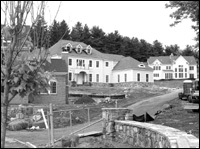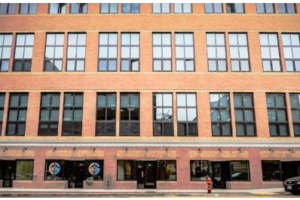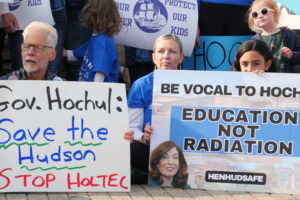 |
|
Spectrum’s Legends at Pocantico Hills will continue with the Legends at Wilson Park. |
All of us in Tarrytown have a personal connection to the Tarrytown Lakes which provides many with a sense of calm every morning and afternoon as they go to or return from work.
Even more so than the Hudson River, the accessibility of the lakes and its trails provides Tarrytowners with a unique natural resource. Today they may not provide our drinking water, but they do represent a source of recreation unique to our Village. The sad fact, though, is that our lakes are dying.
The lakes were man-made and finished in 1888. Originally they were known as the Storm Brook valley, a swampy area that housed several residents who had to be relocated. The stream which ran through the valley was dammed and two lakes were created. They were the primary source of drinking water for Tarrytown for almost 100 years. Presently they are not.
The Village has commissioned a series of studies over the years to find out what is happening. The lakes are undergoing a process whereby they receive excess nutrients from water sources that stimulate excessive plant growth that eventually kills off all life in the lakes. This process is further stimulated by human activities such as residential development, forest clearing and road building. And lawn fertilizers are a big culprit, too.
These studies take the form of huge books with equations and graphs and maps that can easily send you to sleep faster than Ambien, but the basics are that we are killing the lakes and there are precious few things we can do about it. The Manhattan Study suggested further study into issues of groundwater contamination, runoff contamination, and inadequacy of an inventory of the environment. The public requested these further studies and it remains to be seen whether these issues are subject to the Village’s concerns at this time.
One of the very first actions taken by the newly-elected Mayor and Board of Trustees was to pass legislation defining the terms “runoff” and “watershed.” I questioned the change of definition multiple times but never received a satisfactory answer.
The old definition of a “Watershed Area” was defined as “the entire drainage area contributing to the Village of Tarrytown water supply,” which, to me, included ground water. The new definition only characterizes it as surface drainage.
While concerned residents welcomed the new Board’s zeal for legislative activity after only their second Board meeting, a closer analysis of the words of the new law raised additional questions:
What about the ground water contamination? Why is the definition limited to the surface water, when groundwater is also a consideration? Were the concerns raised by the engineers, in the Manhattan Study, about groundwater contamination not to be considered by the Planning Board because of this new legislation? Is this new definition just making it easier for the developer to build his development?
There was not a direct response to the questions, but, a possible side step. The Village was going to hire more consultants, but not the same engineers who performed the original study from Manhattan College.
PUBLIC CONCERN FOR THE DEVELOPEMENT OF 48.1 ACRES AT THE LEGENDS OF WILSON PARK, CIRCA 2005-2006
The owner of the vacant land wants to build houses in Wilson Park. The development is called the Legends at Wilson Park. This land sits on hills above the lakes. The Planning Board is the lead municipal agency as the Village Board of Trustees declined to be a lead agency for this project. Residents are concerned that the runoff from this newly created residential development into the Tarrytown Lakes will cause even more damage.
As part of the public review process, the developer opened the land to a public walk-through in the summer of 2005. At previous public hearings, I and other residents raised the concern of what appears to be a large drainage system on the property. The storm drains are located at the lowest part of the property, downhill from the ridges and Wilson Park Dr. When I stood on the drainage grate I could hear water rushing. When I looked into the storm drain, I could see running water. A gentleman with the group pointed out that there was “obviously a significant manipulation of the terrain.”
The basic questions of who, what, where, when and why needed to be asked.
The public asked those questions at Public Hearings to the Village Board, the Planning Board and the developers. There was no response to simplest of questions. My sense of panic was for the well-being of the lakes. Were these lands draining into the lakes? After the development, when pesticide and fertilizers were applied to the land, would they also drain directly into the lakes? Why does this developer have the right to drain his property into the Tarrytown Lakes? These were legitimate questions to be asked and answered. Instead of answers or any reasonable dialogue, the public was challenged with a set of 3 drawings of alternative sites plans for houses on the site. “Which development plan would you prefer?” was the question presented by the Planning Board to concerned citizens. “No development should occur on the land if the Tarrytown Lakes would be harmed,” was the response on a lot of residents’ minds.
RESULTS OF RESEARCH ON THE HISTORY OF THE TARRYTOWN LAKES, PARKLAND, AND WILSON PARK
An 1880 map of Wilson Park and the area which became the Upper Tarrytown Lake (near to Marymount) inventories the Storm Brook Valley stream which was eventually dammed to make the lakes. Also on the map are the 6 springs whose water fed into the original lake. One of these springs appears to be located on the property to be developed in Wilson Park. On a later Ward Carpenter Map, the railroad line is shown. The same spring is shown again on the property to be developed. Also, a second spring on the east side of the railroad bed is on the map. From the map, it appears that the springs are connected by a stream and feed downhill into the stream and area which become the upper lake. The existence of these 2 springs, which are subject to being impacted by runoff from this development, should be evaluated by our Village and the developer.
Land records show that the railroad bed behind Wilson Park was donated to the Village for the reservoir area and as parkland. This area should not be available to the developer who owns the land for any kind of manipulation, including any construction that would help him install stormwater management drainage.
Village records show that in l984 the then owner of the Legends at Wilson Park land asked for permission to tear down the three vacant mansions on the site. Also requested was permission to fill in the spring-filled pond which drained through the neighbor’s conduit. The pond was filled in and the overflow is no longer evident. An underground drainage system for the pond and surrounding area appears to have been installed and connected to the conduit of the adjoining land owner; this drains directly into the lakes. On the east side of the rail bed where the conduit drains (this is the lake side), you can now see a long pipe which leads the water east several hundred feet toward the lakes. The water direction was changed from the original easement where it was supposed to run south to the benefit of the lower land owner. I question if this is a current major source of pollution to the upper lake.
In addition to the present flow of water through our parkland, the developer has proposed for his drainage purposes another drainage system more elaborate than what was built in l984. This proposal also plans to use the conduit through our parkland with the construction of retention ponds nearer to the Tarrytown Lakes.
The rail bed was village parkland at the time the l984 drainage work was performed and presently remains parkland. State Law requires that the Village obtain permission from the NYS Legislature before it transfers any interest in parkland to a private individual. Village Officials must tell the public if proper permission to direct this water though public parkland was and will be obtained. To me, there is no reason that all of the property owned by Spectrum should drain directly into our lakes, now or in the future!
CONCLUSION
We can dredge the lakes (we did that in 1992), we can aerate (like we do in our fish tanks, but on a much grander scale), and we can add chemicals. It all costs a lot of money. Most people who have become involved in saving the lakes over the past couple of years are familiar with all of this.
The big controversy though, is over the development called the Legends at Wilson Park. Hearings are held at the Planning Board and at the Village Board. The public has raised many questions. At issue: the lakes themselves, an inventory of the natural resources, an inventory of trees, the flow of surface water and ground water, the impact on the lakes, storm water management.
I will go to Albany and challenge any decision by Tarrytown officials that allows this developer to direct runoff through our parkland toward the Tarrytown Lakes. I will not be alone.
Most concerned members of the public would probably say that they have not received any clear and concise response from the Village, from the Planning Board, or the developer.
A group of residents have banded together and created the Tarrytown Conservation Committee. Mayor Fixell has refused to grant this committee official status as he has conferred to other Village Committees, such as the Ethics, Waterfront advisory, or Beautification Committees. We have hired at our own expense an engineer and attorney to scrutinize the request to develop the land. The issue of the damage to the lakes from runoff, both above ground and below, has been presented. We still await satisfactory answers.
Michael Farley was the previous Village Historian of Tarrytown, a frequent contributor to this publication, a founding member of Tarrytown Conservation Committee and is presently a Candidate for Public Office of Trustee in Tarrytown.




